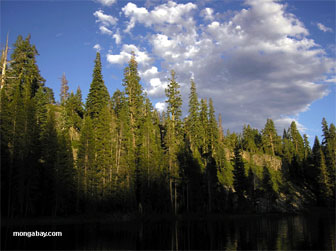Forests cover 1/3 of U.S. but are responsible for 2/3 of its water supply
Forests cover 1/3 of U.S. but are responsible for 2/3 of its water supply
mongabay.com
July 16, 2008
The single most important function of U.S. forests is their role in securing the country’s freshwater supply at a time when water demand is surging but climate risks to forests are also increasing, say the authors of a new federal report released by the National Research Council.
The report, titled Hydrologic Effects Of A Changing Forest Landscape, looks at how better management of forest resources could increase water supplies and quality. It identifies future research needs and examines how changes to forest cover — including wildfires, insects, climate change, road networks, loss of the forest canopy, and applications of chemicals like fertilizers and fire retardants — can impact the water output of a forest.
“Historically, forest managers have not focused much of their attention on water, and water managers have not focused on forests,” said Julia Jones, a professor of geosciences at Oregon State University, and vice chair of a committee of the National Research Council. “But today’s water problems demand that these groups work together closely.

|
“Because forests can release slightly more water for a decade or so following timber harvest, there have been suggestions that forests could be managed to increase water supplies in some areas,” Jones said. “But we’ve learned that such increases don’t last very long, and often don’t provide water when you need it most.”
The report shows that while forests cover about one-third of the country’s land area, they provide filtration and storage systems for nearly two-thirds of the water supply. The report argues this function is probably more valuable that others — including carbon storage, timber production, wildlife habitat, recreation and wilderness — provided by healthy forests.
The report notes that modifications to forests can reduce water yield and quality. Among these the report lists forest harvesting; “impervious surfaces” such as roads which increase overland flow, deliver water directly to stream channels, and can increase surface erosion; forest chemicals, including those used to fight fire, which can adversely affect aquatic ecosystems; and permanent conversion of forested land to residential, industrial and commercial uses. The report warns that climate change could worsen risks to domestic water supplies by increasing fire frequency and insect or disease epidemics in forests.
Hydrologic Effects Of A Changing Forest Landscape
Related articles
Climate change fuels more forest fires in the United States July 6, 2006
New research says the frequency of large forest fires has increased in the western United States since the mid-1980s as spring temperatures climbed, mountain snows melted earlier and summers got hotter. The new findings, published in the July 6 issue of Science Express, suggest that climate change, not fire suppression policies and forest accumulation, is the primary driver of recent increases in large forest fires.
United States has 7th highest rate of primary forest loss November 16, 2005
Primary forests are being replaced by “modified natural,” “seminatural,” and plantation forests in the United States according to new deforestation figures from the United Nations. Monday, the Food and Agriculture Organization of the United Nations (FAO) released its 2005 Global Forest Resources Assessment, a regular report on the status world’s forest resources. FAO found that the United States has the seventh largest annual loss of primary forests in the world, ranking it the worst among wealthy countries in that department.
This article is based off press materials from Oregon State University and the National Research Council







